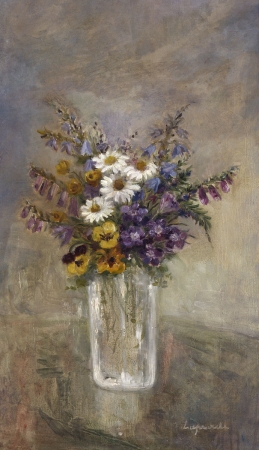LAPRADE, Bouquet of Wild Flowers

Pierre LAPRADE (1875-1931)
Bouquet of Wild Flowers
oil on canvas
61.5 x 38 cm
© MuMa Le Havre / Florian Kleinefenn
Bouquet of Wild Flowers
oil on canvas
61.5 x 38 cm
© MuMa Le Havre / Florian Kleinefenn
HD image
"No one has understood the poetry of a bouquet like him. His dark gold ears of wheat, his wild flowers, his pale, tart lemons add true colours, bright greens and yellows, vivid pinks, immaterial blues, the grey mist of his backgrounds. And his infinitely varied greys are nuanced with all the fine details that can be seen by the human eye." When flowers are not used as garlands to frame Laprade’s vast landscapes or gardens, they find their place in a vase against a neural background, a simple still life.
In Bouquet of Wild Flowers, the sober vase made of clear glass lets the nuanced tones of grey from the wall show through. Fine and delicate brushwork is used to convey the lightness of the blue bells and anemones, bathed in a soft glow. The violet of their petals appears to penetrate the harmonies of grey in the background. A few thick touches of white are enough to give shape to the daisies placed in the centre of the bouquet. His luminous whites also give the vase shimmering reflections that assert its full materiality.
Laprade arranges and combines his flowers in bouquets filled with grace and nobility. "The wild flowers, poppies, cornflowers, simple roses mixed with wheat that he loved are not bouquets from nature, but interior floral arrangements. He did not content himself with planting the flowers roughly in a copper or stoneware jug, like Vlaminck, but rather artistically arranging them in a vase of old Rouen faience. All of Laprade's work, wistful and dreamy, reveals the soul of a poet.”
In Bouquet of Wild Flowers, the sober vase made of clear glass lets the nuanced tones of grey from the wall show through. Fine and delicate brushwork is used to convey the lightness of the blue bells and anemones, bathed in a soft glow. The violet of their petals appears to penetrate the harmonies of grey in the background. A few thick touches of white are enough to give shape to the daisies placed in the centre of the bouquet. His luminous whites also give the vase shimmering reflections that assert its full materiality.
Laprade arranges and combines his flowers in bouquets filled with grace and nobility. "The wild flowers, poppies, cornflowers, simple roses mixed with wheat that he loved are not bouquets from nature, but interior floral arrangements. He did not content himself with planting the flowers roughly in a copper or stoneware jug, like Vlaminck, but rather artistically arranging them in a vase of old Rouen faience. All of Laprade's work, wistful and dreamy, reveals the soul of a poet.”
















